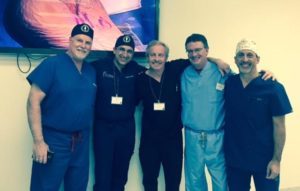Research
Dr. James Anderson is passionate about treating diabetic and idiopathic neuropathy and is a leading expert in the field.
He is dedicated to researching nerve procedures that treat neuropathy, restless legs, drop foot, and nerve pain, and he conducts several research studies.
His ongoing research aims to demonstrate the effectiveness of procedures that treat neuropathy, drop foot, and restless leg syndrome and also prevent falls and help with balance and gait problems (like falls).
Intraoperative Nerve Monitoring

The concept of monitoring nerve function during nerve surgery has long been used with head, neck and spinal surgery, but has not been considered for lower extremity surgical cases. At Anderson Podiatry Center for Nerve Pain we were the first to utilize this concept. If it’s good enough for the head, neck, and back it should be good enough for the foot and lower extremity!
So, how is it used?
To reverse the life-altering symptoms of neuropathy and restless legs. We open nerve tunnels that are causing too much pressure and injuring your nerves. While the surgery is being performed the Nerve Integrity Monitor (NIM®) machine (the leading nerve monitoring system used in most of the hospitals in the US and created by Medtronic), monitors the progress of the surgery. We take measurements before and after the tunnel is opened. We then have a paper report of how much the nerve function improved in the operating room. It’s very exciting to see as much as 300 percent improvement in some patients! This reported improvement in the operating room translates to functional improvement for the patient, oftentimes in terms of dramatically improved and even reversed symptoms of neuropathy (numbness, tingling, burning sensations) and restless legs.
We share this information with the patient immediately after surgery, much to their delight.
We also use the data collected to do studies which are being used to demonstrate to the rest of the medical world that our procedures have a very positive effect for those suffering from neuropathy or restless legs. The following are some facts that Medtronic would like you to know, to help you understand the significance of what we do. They are excited about our results and consider it an important contribution to the medical community:
- Anderson Podiatry Center for Nerve Pain is the first facility to integrate intraoperative nerve monitoring into lower extremity surgery.
- We perform more intraoperative nerve monitoring procedures than anyone in the Rocky Mountain region, and possibly the country.
- We are helping to pioneer the concept of intraoperative nerve monitoring use in the lower extremity, in conjunction with Medtronic.
- Our experience has shown us that monitoring nerve function during surgery gives us the best opportunity to optimize improved nerve function.
- Nerve monitoring reduces the risk of intraoperative nerve injury (according to research by the International Neuromonitoring Society for Thyroid Surgery)
- Intraoperative Nerve Monitoring provides feedback to the surgeon for more complete nerve treatment
Speak to one of our doctors today to learn more about intraoperative nerve monitoring. We feel it’s a useful tool and can help to improve the outcome of the procedures that we do for neuropathy and restless leg symptoms.
Photos of Dr. Anderson at the Association of Extremity Nerve Surgeons Conference where they discussed Anderson Podiatry Center’s revolutionary Intraoperative Nerve Monitoring procedure.
Winning the Jules Tinel Award: My Journey
The Patient Who Started It All
15 years ago I ventured into an other-than-conventional realm of medicine to explore innovative and non-traditional approaches to peripheral nerve problems in diabetics. Little did I know it would change my professional life forever. Back then, I never thought that one day I would work to reverse the symptoms of neuropathy (the burning, tingling, numbness and pain many diabetic and non-diabetics suffer with).
It started the day I met a patient. He was diabetic, and hadn’t felt the bottom of his feet in 20 years. I was training with a Johns Hopkins plastic surgeon, Dr. Lee Dellon, who had performed a new type of surgery on the patient four days earlier. Dr. Dellon stroked the bottom of the patient’s foot, and this stoic man began to laugh like a child, followed by crying tears of joy that he could now feel his feet after so long. I knew right then and there that I wanted to prove to the medical world that the symptoms of neuropathy could be reversed, and that patients didn’t have to suffer and live on medication.
How the Research Started
Several like-minded colleagues and I soon helped form an organization called the Association of Extremity Nerve Surgeons. This organization includes podiatrists, plastic surgeons, neurosurgeons and orthopedic surgeons who all share a common goal of reversing nerve pain in the extremities. New-found passion grew for how the procedures I was performing were transforming people’s lives. The drive to do research came to me out of the frustration and difficulty that existed in patients and doctors understanding that neuropathy can be reversible, so I had to prove it.
Gradually, research became a part of our practice. I was warned that research is very hard, and that proved to be true. The process to do this started several years ago and the research continues to this day.
Research On Diabetic Neuropathy
Too many people are suffering from the symptoms of neuropathy, and too many diabetics have amputations and are at risk of dying because of the loss of their limbs. Because of this, we were compelled to complete a study on intraoperative nerve monitoring in diabetics with severe neuropathy. No one had ever recorded and published a paper to prove that nerve function can rapidly be improved when tight nerve tunnels in diabetics are opened (decompressed).
The study objectively proves what I watched the patient I mentioned earlier experience. Our testing shows that the nerve function improves up to 300 percent within minutes during surgery. This defies conventional medicine’s view. This study was ground breaking, and my hope is that along with other studies that have been and will be published, the thoughts of the medical world and the public will begin to shift and more patients can experience relief from this debilitating problem.
Winning The Jules Tinel Award
Recently, I attended the annual meeting for the Association of Extremity Nerve Surgeons. At the meeting, I was honored to receive the Jules Tinel award for the scientific advancement of knowledge regarding the human peripheral nervous system. Other doctors to have received this award are Dr. Lee Dellon from Johns Hopkins, who introduced the concept of nerve decompression for neuropathy, Dr. Maria Seminow from the Cleveland Clinic, the first American doctor to do a face transplant, and Dr. Ivan Ducic of Georgetown Medical School, the first doctor to surgically reverse severe headaches.
We all appreciate recognition, but it’s very special when it’s coming from your peers. I’m grateful to have received this award, and grateful for all the support given to me by my colleagues and the team that helps me, and from my wife who has always understood and supported me.
And I’m especially grateful to all the patients who have trusted in me and taught me to be grateful for the ability to offer hope where there once was none.
To learn more about neuropathy, and how we treat it, click here.
To make an appointment, click here.
Published Research Papers
Diabetic Neuropathy Research Paper 1
The first published paper showing objective evidence that nerve decompression surgery can reverse diabetic neuropathy. Intra-operative nerve monitoring with EMG testing was used to test nerve function before and after nerve tunnels were opened. | Aug 9th 2016
Diabetic Neuropathy Research Paper 2
Additional information showing how much improvement was observed in patients based upon diabetic control, length of diabetes, age , weight etc. | July 4th 2019
Restless Legs Syndrome
First paper to show evidence that the symptoms of Restless Legs Syndrome can be reversed by decompression of nerve tunnels in the leg. A second paper will soon be published sharing more rigorous evidence that this may be an appropriate option for some patients.






